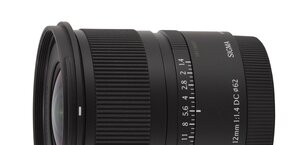Sigma 18-125 mm f/3.8-5.6 DC OS HSM
3. Build quality and image stabilization
 |
Sigma begins with a metal bayonet, standing out nicely against the plastic Nikkor 18-105 mm VR and 18-135 mm Nikkors. Right behind it, on the left side, we find a switch for focusing mechanism mode (AF/MF) and a switch for stabilization (OS On/Off). Even further there’s a big and convenient ring for changing focal length. It turns smoothly with an appropriate resistance, which remains the same in whole range. Nice for this price range lens. Above the zoom ring we find another ring, this time for manual focusing. It’s smaller, but allows convenient work. There’s a distance scale on it, expressed in feet and meters, which extends from 0.35 meter to infinity. At the very end we find the front system of lenses, which is surrounded with a non-rotating filter mount of 67 mm diameter, and which protrudes on a telescopic barrel making the dimensions of the lens increase to nearly 14 cm.
Please Support UsIf you enjoy our reviews and articles, and you want us to continue our work please, support our website by donating through PayPal. The funds are going to be used for paying our editorial team, renting servers, and equipping our testing studio; only that way we will be able to continue providing you interesting content for free. |
- - - - - - - - - - - - - - - - - - - - - - - - - - - - - - - - - - - - - - - - - - - - - - - -
 |
Sigma 18-125 mm OS, having a wide range of focal lengths and image stabilization, is an optically complicated lens. It contains 16 lenses in 12 groups. The producer was generous with special elements like three aspherical lenses and one low-dispersion element of SLD glass. Inside the lens we also find a circular diaphragm with seven blades, which, depending on the focal length, can be closed down to f/22 or f/32.

A buyer gets both caps and a lens hood in the set. In standard, the lens has a 2-year warranty, but after paying extra charge you can extend it for another year.
 |
Stabilization
The producer assures that the image stabilization works with 4 EV efficiency, so allows exposure times 16 times longer than those we can get using a lens of the same focal length without image stabilization.
Let’s look at the graph below to see how the producer’s assurances correspond with the facts. The graph presents percentage of unsuccessful images for 125 mm focal length, depending on the exposure time expressed in EV (0 EV corresponds to 1/200 second).

The average distance between the curves tells us about the efficiency of stabilization. We can see that it’s not bad, as the curves are separated by around 2.5 EV, and with longer times even 3 EV. It’s a typical result for this price range, but still lower than what the producer pledges.
What’s interesting, contrary to what you can read in some readers opinions, the stabilization worked noiselessly in our lens.






